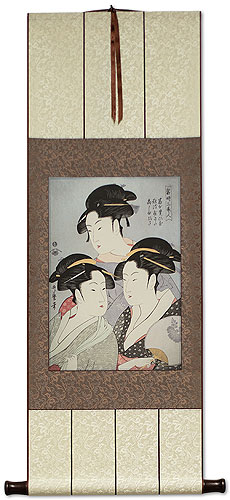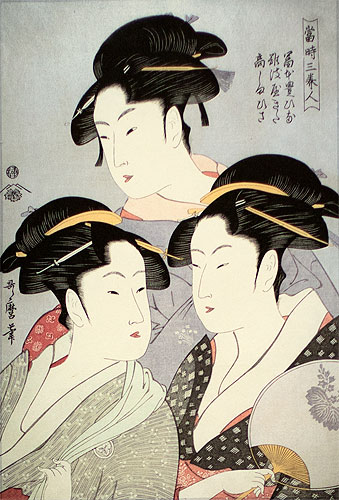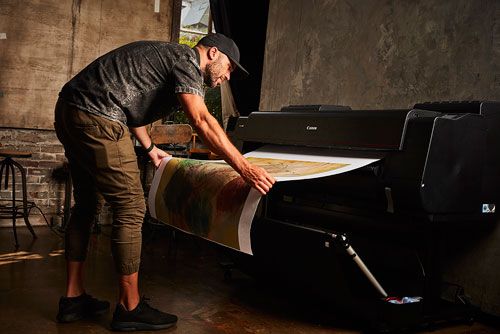
41½"
18¼"

Approximate Measurements
Artwork Panel: 28.2cm x 43.5cm ≈ 11" x 17"
Silk/Brocade: 37.4cm x 105.6cm ≈ 14¾" x 41½"
Width at Wooden Knobs: 46.4cm ≈ 18¼"

Close up view of the artwork mounted to this silk brocade wall scroll





Tōji San Bijin
This is a lovely image of the three famous Edo-era beauties, 富本豊ひな / Tomimoto Toyohina (top center), 難波屋おきた / Naniwaya Okita (bottom right), and 高島屋おひさ / Takashima Ohisa (bottom left).
Naniwaya Okita holds a fan, while Takashima Ohisa clutches a towel around her neck, wearing an intricately detailed blue striped kimono patterned with tiny embossed leaf motifs. Beautifully detailed with fine line work in the hair. A charming group portrait of these three women.
Naniwaya Okita and Takashima Ohisa are believed to have been 15 and 16 respectively at the time of the portrait. Both were daughters of successful tea house owners. Much of the success of those tea houses are attributed to the work of these girls to bring in and serve tea to customers. It may not be obvious, but both girls are wearing the basic clothes of tea house girls - elegant, but not-too-fancy.
In contrast, at the top is the comparatively elder Tomimoto Toyohina, a famed geisha of the Tamamuraya house in the Yoshiwara pleasure district. Tomimoto is dressed in fancier geisha-style attire.
There are several versions of this print, so you will also see it titled, 寛政三美人 / Kansei San Bijin "Three Beauties of the Kansei Era" and 高名三美人 / Kōmei San Bijin "Three Famous Beauties".
To the left, above Takashima Ohisa's hair, you will see a round censor stamp that says【極】or kiwame, meaning "approved". This was the stamp used by the state in Japan to authorize publication from 1790 until 1805.
To the left, below Takashima Ohisa's hair, you will find a signature with the pen name 歌麿筆 (Utamaro Hitsu). The artist's full name is 喜多川歌麿 (Kitagawa Utamaro). He was born in Japan in Edo (now known as Tokyo) around 1753. He only lived to the age of 53, dying in 1806.
Original artist: Kitagawa Utamaro 喜多川歌麿 (1753-1806).
Publisher: Unknown.
Original woodblock was created in Japan, in 1792 or 1793.
Woodblock printing, often considered the precursor to the modern printing press, was first developed in China and later brought to Japan, where artists refined the technique into a unique art form. In Japan, these prints are called 木版畫 ("Moku Hanga"). Most were created during the Edo period (1603–1867), though production continued into the early 20th century.
Japanese artists would first create a "template painting" depicting scenes of daily life, including women washing clothes, men writing poetry, samurai battles, and occasionally more dramatic subjects. These template images, known as 浮世絵 (Ukiyo-e, or "Floating World"), were then carved into wood by skilled artisans. Another specialist applied wet ink or pigments to the carved blocks, and a sheet of handmade paper was pressed on to create the final print. This collaborative process produced vibrant, detailed artworks much faster than hand-painting hundreds of copies.
Original Japanese woodblock prints from the Edo period can sell for $800 to $20,000. Our prints are high-quality reproductions, crafted to capture the look and feel of the originals, though experts will recognize them as reproductions.
We use authentic handmade kozo (mulberry) paper—the same paper Japanese printmakers used centuries ago. Archival, UV-resistant pigment inks ensure long-lasting color, with laboratory testing showing up to 95 years of fade-free enjoyment if kept out of direct sunlight. Each reproduction is carefully color-corrected and restored, bringing the Edo period artwork to life for your wall.

Photographer Jeremy Cowart and the Canon imagePROGRAF PRO-2000 giclée printer used to create these reproductions.
Printing on delicate handmade paper is challenging. After testing multiple high-end printers, we found the Canon imagePROGRAF PRO-2000 delivers the precision and quality needed, using 12 archival inks and 18,432 nozzles. Each print is then sent to our Beijing workshop, where it is mounted into a handmade wall scroll, ready-to-hang without the need for expensive framing, giving your piece an authentic Japanese look.
Because the original artist has long passed, these works are public domain. In some cases, we license high-resolution scans of original prints, or even scan 200-year-old originals ourselves. This dedication ensures you receive a stunning Japanese woodblock print reproduction at an affordable price, making traditional Asian art accessible to everyone.
Want a custom wall scroll or unique print size? Just contact us!
We can print larger sizes, choose your preferred paper texture, and select silk brocade colors. Ready-to-frame prints can ship in days, while custom wall scrolls may take several weeks. Either way, the result is a truly one-of-a-kind piece of Japanese art.